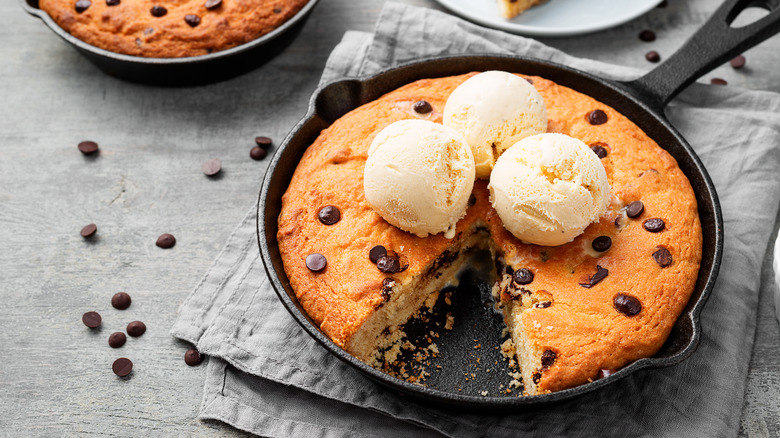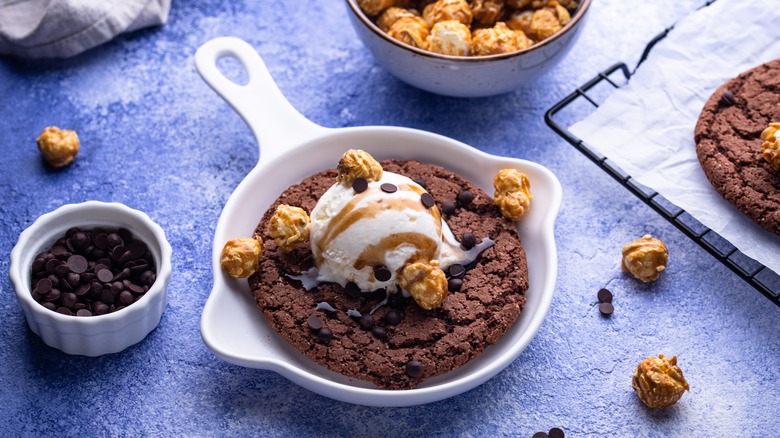You Don't Need Cast Iron For A Crispy, Gooey Skillet Cookie
Sometimes when you're craving a cookie, you may not want to spend the time rolling out individual servings. Instead, you can scoop the batter into a skillet and bake it up into one giant, gooey chocolate chip cookie. Then, after it's baked, you can slice it up into individual servings, or simply dig in with a spoon.
Typically, cast iron skillets are used to create these giant cookies. The material stays heated consistently throughout the entire skillet, allowing for an even bake. But some cast iron skillet brands can get pricey if you opt to invest in a higher-end one, and you may not want to spend the money if you already have another skillet that you love using.
Fortunately, cast iron skillets aren't your only option. If you want to bake up a warm, gooey, giant cookie, there are a few other kinds of skillets that you can use to achieve the same result: Enamel, copper, aluminum, and stainless steel skillets will all work just as well. If you already have a non-cast iron skillet in your kitchen, you'll just need to make sure it's oven-safe before baking with it.
What should you look for in an oven-safe skillet?
The major factor that you'll want to pay attention to is whether or not your skillet is oven-safe. Enameled cookware often has either a steel or cast iron interior. Both of these materials allow for high heat and are safe for use in the oven. You can even preheat the enameled skillet in the oven while you mix up your cookie dough. This could help the heat to distribute more evenly as the cookie bakes.
Most stainless steel (just be sure to avoid lower quality stainless steel) is safe for use in the oven because it is generally made from a metal alloy that can withstand high temperatures for baking. You can also search specifically for 18/10 stainless steel, which is made from 18% chromium and 10% nickel. This blend can help the cookware to stand up to high heat a little better. Aluminum and copper skillets can also hold up to heat and are generally safe for baking, as well.
However, you should always pay attention to the specifications of your cookware prior to baking with it. Some skillets have temperature limitations and may not be able to withstand the full heat from the oven (some metals are only safe in the oven up to 350 degrees Fahrenheit). Additionally, there are a few instances where you shouldn't use your skillet to bake at all.
When not to bake with your skillet
Even if your skillet is oven-safe, you'll also need to research the temperature restrictions. While some skillets can withstand up to 500 degrees Fahrenheit, others shouldn't be heated beyond 350. Although that is sufficient for some cookie recipes, temperature recommendations can fluctuate depending on the recipe, so you'll need to do a little research before you turn up the heat.
Before you begin baking, you'll want to pay close attention to the material of your skillet's handle. If your cookware is made entirely out of the same oven-safe material, it's probably safe to bake, so long as the skillet's specifications don't say otherwise. But if the handle is made from rubber, wood, or plastic, do not put it in the oven. The handle could burn or melt in the oven and make a mess.
If you don't have a cast iron skillet handy for the next time you're craving a giant cookie, feel free to check your other cookware. So long as your skillets are oven-safe, they can bake up similarly sweet results.


